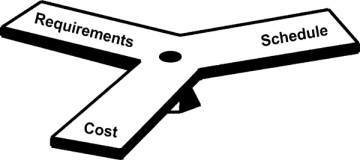10 Steps To Better Requirements
Critical Review of
Authored By
Ian Alexander
Reviewed By
- Saksham
- Shubham Virmani
- Siddhant Roy
- Saurabh Jaiswal
- Vishal Sethi
- This research paper primarily focuses on providing certain guidelines to improve requirements for a project to the point where they are good enough.
- Good requirement analysis plays a pivotal role in success of a project as they are direct implication of the needs of the customer.
-
The detailed steps listed in the paper break this analysis into manageable modules and by using management tools and specialized models we can prioritize our requirements to cater to goals of project.
Introduction to the Project
1. Mission And Scope

Context Diagram
- Understanding the mission guidelines
- Benefits of Context Diagram over Use Case Diagram.
2. Stakeholders
- Identifying all stakeholders involved in the project
- Prioritize their involvement in the system.

3. Goal
- Identifying goals of stakeholders
- Breaking large goals into small ones.
- Goals should be acquired in a two tier system -> Building basics & Upgrading developed software
4. Goal Conflicts

- Determining which goals provide a boost to our main goal and which utilize our resources unnecessarily
- Resolving conflicts as soon as possible
5. Scenarios
- Considering all possible scenarios which can occur during the course of project.
- Breaking down a project into different kind of scenarios.
- It don’t treat goals individually but as a step in process of ultimate goal development.
6. Requirements
- Avoid the “shall” phrase in our analysis and replaces it with “must” phrase by clear description of necessary features.
- They are techniques for interfaces, constraints (such as time and cost) and qualities (such as security, usability, dependability).
7.Justification
- Regulating demand with effort
- protecting vital requirements being dropped
8. Assumptions
- These are the things that we need to be true but can’t control.
- Assumptions can include beliefs about existing systems, interfaces, competition, the market, the law, safety hazard.
9. Agreed Priorities
- Prioritizing Requirements
- Dividing Requirements Using Triage
- Focus On vital task first

10. Acceptance Criteria
- Acceptance depends on the result obtained when it is applied to various test cases
- Plan the test campaign on the basis of scenarios for each requirement
- Trace the test cases to demonstrate coverage.
Critical Review of
Supporting Requirements Based On Video Analysis
Authored By
Marina Jirotka
Paul Luff
Reviewed By
Saksham
Vishal Sethi
Shubham Virmani
Saurabh Jaiswal
Siddhant Roy
- In any business setting, there are skills, tricks of the trade, and ways of communicating that are hard or nearly impossible to describe through traditional methods
- The research paper attempts to highlight the benefits of modern ethnographic methods over the primitive requirement engineering techniques like interviews
Case Study Of A Dealing Room
Problems Faced
- Dealers’ unique speech skills.
- Various abbreviations and jargon.
- The undesirable noise was invaluable for different kinds of collaborative work
- For example ripping a ticket out of a book revealed several things a deal had been made which couldn't be analyzed with audio.
Advantages of Video Based Analysis
- Offered a rich, detailed way for designers to consider alternative scenarios.
- It offered radical ways of supporting coordination and
- Providing a detailed analysis of the workplace.
Disadvantages
- People knew that they were being monitored which could have easily affected their workplace behavior.
- In contrast a limitation of the durability and ease of sharing digital video (particularly in a context of access to social media and YouTube) can heighten concerns in relation to ethics and anonymity.
- Videos take a large amount of time to watch and review can be difficult to meaningfully summarize.
- It records interactions over short period of time which may lead to discontinuity in our observation.
What To Add
- Counseling session should be organized to make workers aware of the advantages of video analysis techniques thus helping them to adapt to the new work environment.
- Applying this technology development in various domains including air traffic and other control rooms and heath care, public setting such as museum setting etc.
SE - 1
By Saksham Arya
SE - 1
- 772



